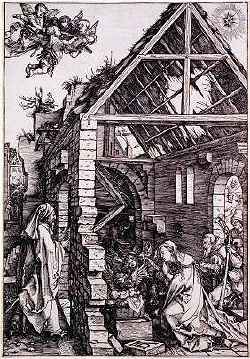Perspective
In this engraving by the German artist Albrecht Dürer*, the new-born Christ is attended by angels, while the first of the shepherds enter from both sides.
The Christ child is still the centre of the composition, but He is dwarfed by the surroundings. The building dominates, with its sweeping perspective and the "cut-away" effect of the opening through which we see Mary and the baby; the dilapidated state of the very European stable emphasizes the humble origins of Christ.
By the time Dürer was working, perspective had become a sophisticated and expressive technique, but it had only been discovered a hundred years before. Perspective was developed by several artists in the early fifteenth century. Their discovery was that the illusion of depth could be achieved by the paradox that parallel lines do actually seem to meet at some point in the distance.
The discovery of perspective in art seems actually to have changed the way we see the world around us. One of the earliest references to the effect of distance on apparent size is in King Lear, where Edgar, preparing his father for what he thinks is suicide, describes the appearance of the beach* as if he were on a high cliff above it.
Footnotes
-
Albrecht Dürer
Dürer (1471-1528) travelled and studied widely. His major works include many engravings and woodcuts for the new medium of the printing press.
-
A leap of faith
How fearful
And dizzy 'tis to cast one's eyes so low!
The crows and choughs that wing the midway air
Show scarce so gross as beetles. Half way down
Hangs one that gathers samphire, dreadful trade!
Methinks he seems no bigger than his head.
The fishermen that walk upon the beach
Appear like mice . . .
(4.4.11-18)
choughs: small crows
gross: big
samphire: a herb that grows near salt water
